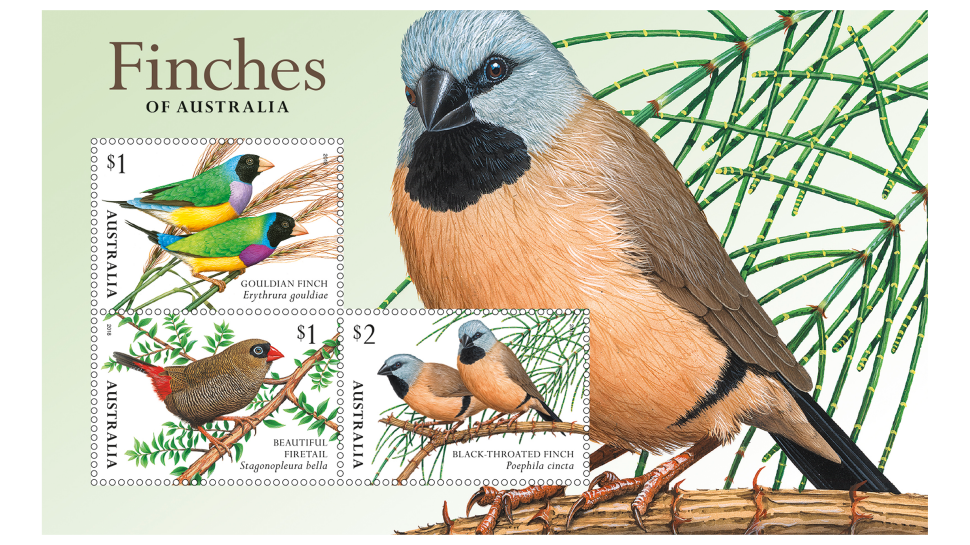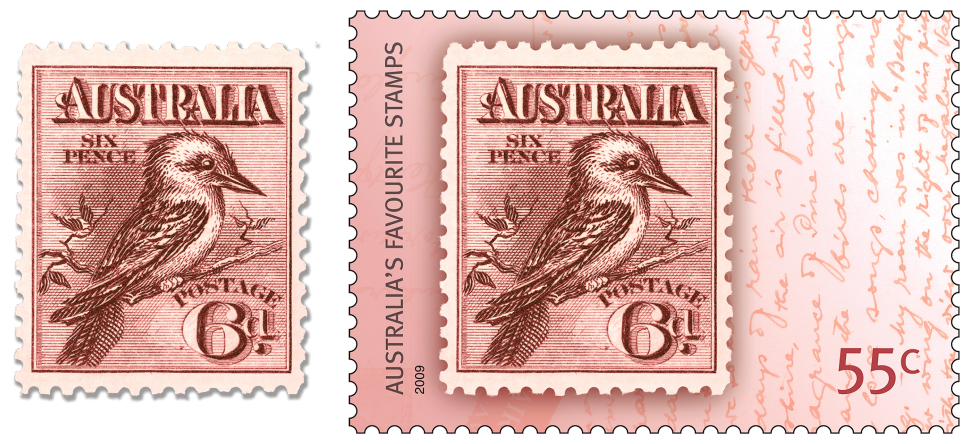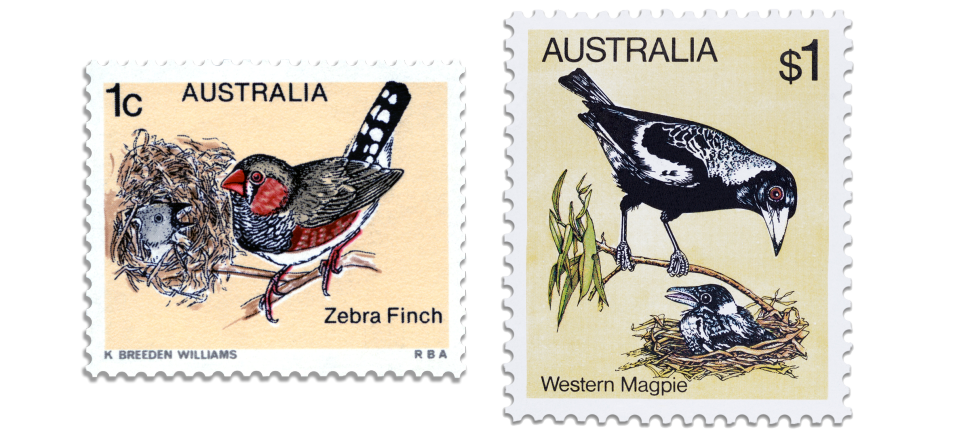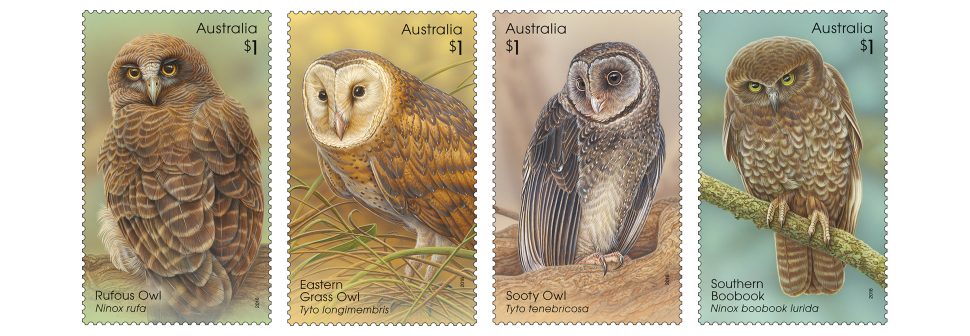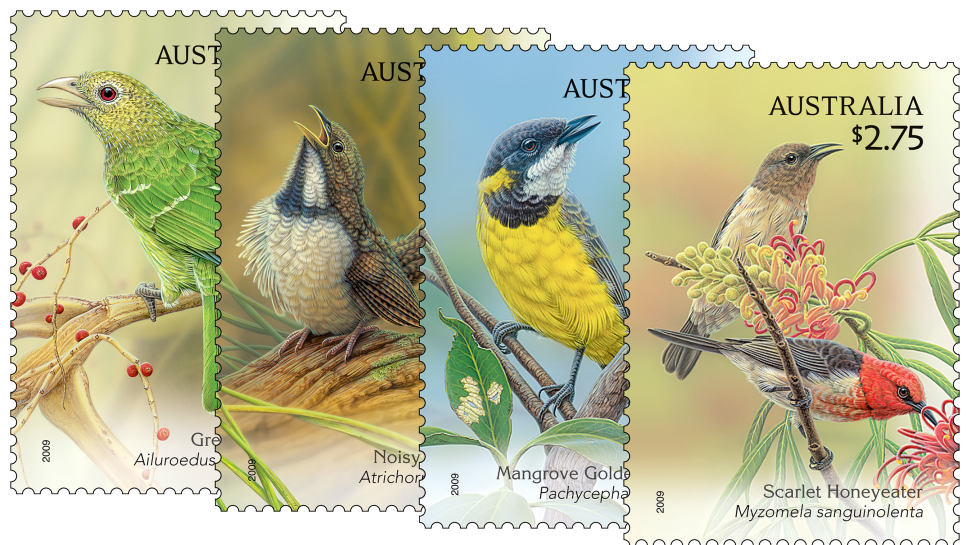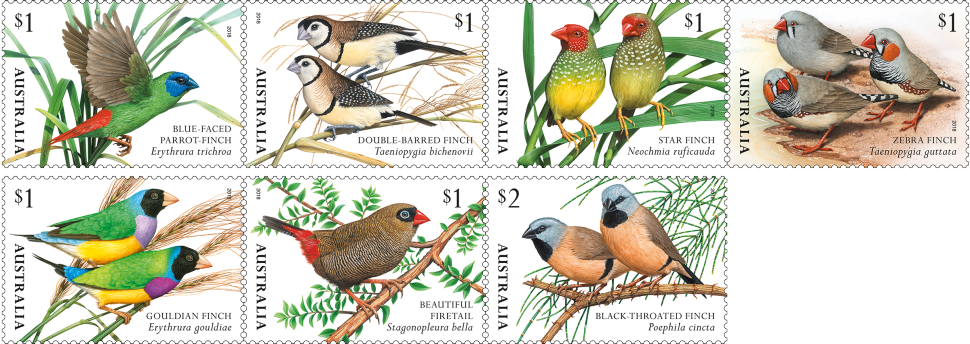From the Emu and Lyrebird stamps from the 1888–9 Centenary of NSW stamp issue to the two Finches of Australia stamp issues of 2018 (one released on 16 March 2018 and the other on 5 June 2018), birds have been a popular and evocative theme in the history of Australian stamps.
Australian stamps have featured water birds, wetland birds and desert birds. They have presented birds from the Dreamtime, as well as both common species and endangered species. There have been highly colourful species and the more subtly coloured, in all shapes and sizes – from the large brown emu to tiny brightly decorated finches and everything in between.
Birds for commemoration
The 8d magenta Lyrebird stamp design of 1889 arose out of a Centennial stamp design competition and became part of the world’s first commemorative stamp issue. (The 1888–9 Centenary of New South Wales stamp issue was the first adhesive commemorative stamp issue to be released worldwide.) And, in fact, many early Australian bird stamps have been issued to commemorate centenaries and events. The first bird stamp issued by the Commonwealth was the 1914 6d claret Kookaburra stamp, and the Centenary of Western Australia stamp issue of 1929 featured a 1½d red Swan (followed later, in 1954, with a 3½d stamp to commemorate the centenary of the first Western Australian postage stamp, this time with a more synonymous black Swan design, 3½d). The 1946 Peace and Victory stamp issue, to commemorate the end of World War II, included a 3½d blue Dove and Flag (re-issued in 1995 as a $1.50 stamp for the 50th Anniversary of Peace in the Pacific stamp issue).
In the decimal era, the 1974 Centenary of the Universal Postal Union stamp issue featured pigeons (appropriately, as they are the carriers of messages), in 7c and 30c designs, and the 1975 stamp issue commemorating independence by Papua New Guinea featured a 25c graphic Bird of Paradise design.
Philatelic firsts
Bird designs have also featured in a series of Australian philatelic ‘firsts’. The first Australian minisheet was issued in 1928 for the Fourth Australian Philatelic Exhibition, and featured a 3d blue Kookaburra design (based on the iconic 1914 6d. Kookaburra design).
In fact, the Kookaburra has proven to be a popular stamp subject – most likely because this ‘laughing’ bird has become synonymous with the sights and sounds of the Australian bush. Even though the 1914 and 1928 Kookaburra design was modified in 1932 and in 1937 (each time becoming more ‘delicate’ in appearance), it’s the robust and cheerful 1914 design that still resonates with collectors. In fact, a reproduction of the 6d 1914 Kookaburra stamp featured in the Australia’s Favourite Stamps (a 2009 issue celebrating 200 years of Australia Post) as a 55c stamp. A reproduction of the 1928 3d Kookaburra was featured on the stamp and minisheet issued to celebrate 1978 National Stamp Week, and Kookaburra stamps have formed part of the 1983 and 1990 Christmas stamp issues, 1986 and 1993 Australian Wildlife, 2005 Bush Wildlife and 2010 Australian Kingfishers.
In 1964–65, birds were the subject of the first multicolour definitive stamps issued in Australia. Seven bright and beautiful designs were released, illustrated by renowned Australian bird artist Betty Temple Watts (1901–1992): a 6d Yellow Tailed Thornbill; 9d Black Backed Magpie; 1s.6d Galah; 2s Golden Whistler; 2s.5d Blue Wren; 2s.6d Scarlet Robin; and 3s Straw-necked Ibis.
Betty Temple Watts developed an interest in birds in her early married life while living in Iran and Papua New Guinea. Although she had studied art as a 19 year old, it wasn’t until her late 40s, when she settled in Melbourne, Australia that she decided to focus on bird art completely, and she was producing art well into her late eighties. Betty Temple Watts observed bird species in their natural habitat and made her initial sketches there, adding to the lifelike quality of her artwork.
Work began on the 1964–65 definitives at the beginning of 1959, when Temple Watts produced a series of paintings to test out different compositions for producing multi-coloured designs. By this stage, Australia had turned its mind to producing multi-coloured designs, which had become the trend overseas. However, stamp printing facilities in Australia at that time were limited to one-colour intaglio printing. In 1956, two of the stamps issued as part of the XVIth Olympiad Melbourne stamp issue were printed in multi-colour overseas.
With the realisation of the limitations this presented, the Note Printing Branch finally obtained the necessary equipment (albeit requiring a large financial outlay): a Chambon photogravure printing press. (The first multicolour stamp printed and issued in Australia was the 1962 stamp to commemorate the 50th anniversary of the Australian Inland Mission.) For the 1964–64 Birds definitive issue, much experimentation went on in terms of colour combinations and paper, which necessitated many design changes, as did the technical requirements of the new photogravure printing process.
The next Australian philatelic ‘first’ involving bird-themed stamps occurred in 1978, with the release of the first in a series Australian Birds definitive issues (1978–80), designed by Kay Breedon Williams, a highly regarded Australian wildlife artist and co-author and illustrator of seven books on Australian wildlife.
This definitive series was the first decimal stamp issue with denominations ranging from 1c to $1. They were (in order of issue): 5c Hooded Dotterel; 20c Little Grebe; 25c Spurwing Plover; 30c Pied Oystercatcher; 55c Lotus-bird; 1c Zebra Finch; 2c Crimson Finch; 15c Forest Kingfisher; 20c Eastern Yellow Robin; 40c Lovely Wren; 50c Flame Robin; 22c White Tailed Kingfisher; 28c Rainbow Bird; 60c King Parrot; 10c Golden Shouldered Parrot; 35c Regent Bower Bird; 45c Masked Woodswallow; 80c Rainbow Pitta; $1 Western Magpie; and 18c Spotted Catbird.
Renowed bird artists of today
Two talented wildlife artists who have produced many bird-themed stamp designs for Australia Post, from the 1990s and beyond, are Christopher Pope and Kevin Stead.
Adelaide-based Christopher Pope’s work is well known to Australian stamp collectors. Christopher Pope’s love for art and wildlife developed during his childhood, which was spent in small country towns. His beautiful and lifelike artworks have been exhibited since 1995 and form part of Australian and international art collections.
Christopher’s bird-themed stamp designs for Australia Post include Australian Kingfishers (2010), Australian Waterbirds (2011) and Australian Pardalotes (2013). Christopher Pope’s stunning bird illustrations for Australia Post formed part of the 2013 Australia Post publication, Australian Birds: An Artist’s collection.
In 2016, Christopher Pope illustrated the stamp designs for Owls: Guardians of the Night, which comprised four double-definitive sized stamps featuring four captivating species of owl: Sooty Owl (Tyto tenebricosa), Rufous Owl (Ninox rufa), Eastern Grass Owl (Tyto longimembris) and Southern Boobook (Ninox boobook lurida).
The haunting, lifelike illustrations showcase these magnificent and majestic nocturnal birds of prey in their natural habitat, using dark and muted tones. The stamps clearly left an impression with collectors, as the Owls: Guardians of the Night stamp issue topped the Australia Post Stamp Poll for 2016. Christopher Pope’s Australian Songbird designs also topped the 2009 Stamp Poll. Those stamps showcased species from four families of Australian songbird.
Kevin Stead is a wildlife artist, also based in Adelaide, South Australia. Kevin has worked as an illustrator for more than 30 years, painting in watercolour, in gouache on paper and acrylic on canvas. As well as being a frequent contributor to Australian Geographic magazine, Kevin has illustrated several stamp issues for Australia Post, including Species at Risk (2009) and Australian Poultry (2013).
Kevin has illustrated stamps for Endangered Birds (1998), Australian Parrots (2005) and the $1 Superb Lyrebird and $1.10 Laughing Kookaburra stamps from the 2005 Bush Wildlife stamp issue. Most recently, Kevin illustrated two Finches of Australia stamp issues, both released in 2018.
The Finches of Australia stamp designs focus closely on the birds, presenting them on a largely white background to highlight their distinctiveness and beauty. The habitat of each species is indicated through just a hint of vegetation, typical to the species’ habitat. The lifelike illustrations portray the delicacy these small and sociable birds, many of which have intricate patterns.
The Finches of Australia stamp issues (part one and part two) are available now, online, at participating Post Offices and via mail order on 1800 331 794, while stocks last.
View the gallery and technical details from Finches of Australia, released on 16 March 2018.
View the gallery and technical details from the second Finches of Australia stamp issue, released on 5 June 2018.
This article was produced at the time of publication and will not be updated.

